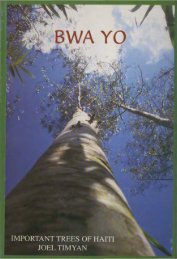Biodiversité - Société Audubon Haiti
Biodiversité - Société Audubon Haiti
Biodiversité - Société Audubon Haiti
Create successful ePaper yourself
Turn your PDF publications into a flip-book with our unique Google optimized e-Paper software.
46<br />
ParulIne bleue<br />
(deNdroica caerulesceNs )<br />
Migrateur<br />
Comme en 2004, cette espèce<br />
a surpassé en nombre les<br />
autres migrateurs pris au<br />
filet, dans les points de<br />
comptage et tous autres lieux<br />
d’observation des 3 sites, sauf<br />
au Pic Macaya où la Paruline<br />
à croupion jaune l’a dépassée<br />
(Tableau 1). Chez ces oiseaux,<br />
les femelles prédominent,<br />
comme dans les habitats<br />
d’autres forêts de montagne<br />
latifoliées d’Hispaniola (Keith<br />
2003, Latta et al. 2003), et<br />
représentent 87 % de toutes<br />
les captures (7/9 oiseaux à<br />
Rak Bwa, 7/7 oiseaux à Pic<br />
Formon). Les individus de<br />
moins de deux ans ont dépassé en nombre ceux de deux<br />
ans et plus (10 de 14 femelles, 1 des 2 mâles). A Rak Bwa on<br />
a capturé 2 femelles baguées en 2004.<br />
ParulIne à crouPIon jaune<br />
(dendroIca coronota)<br />
Migrateur<br />
N’ayant pas enregistré cette espèce en 2004, on a été<br />
surpris de la remarquer assez fréquemment dans le<br />
voisinage de Kay Michel et au Pic Macaya. Alors qu’on n’en<br />
a pas observé à Rak Bwa ou au Pic Formon, on a rencontré,<br />
entre Kay Michel et Rak Bwa, un groupe de 20 oiseaux<br />
dans une parcelle cultivée ayant de jeunes pins éparpillés,<br />
ainsi que 3 autres à Kay Michel. Au Pic Macaya, l’espèce<br />
est classée première en terme d’abondance, avec au moins<br />
35 individus observés (Tableau 1). La paruline à croupion<br />
jaune est connue pour l’augmentation appréciable de son<br />
effectif au cours des dernières années à Hispaniola et à<br />
travers la Caraïbe (Raffaele et al. 1998, Keith et al. 2003, Latta<br />
et al. 2006), phénomène enregistré aussi bien dans d’autres<br />
zones de la région Néotropicale (Ridgeley et Gwynne 1989,<br />
Paynter 1995). Fin janvier 2006, dans les forêts dominées<br />
par les pins, à 1400m d’altitude dans la Sierra du Bahoruco,<br />
on avait observé que le nombre d’oiseaux de cette espèce<br />
était beaucoup plus élevé comparativement à toutes les<br />
autres années, depuis que l’inventaire relatif à cette espèce<br />
a commencé en 1995.<br />
black-throated blue Warbler<br />
(dendroIca caerulescens)<br />
As in 2004, this species outnumbered any other migrant<br />
in mist net captures, point count detections, and overall<br />
detections at all 3 sites, with the<br />
exception of flocking Yellowrumped<br />
Warblers observed on Pic<br />
Macaya. (Table 1). Females again<br />
predominated over males, as in<br />
other montane broadleaf forest<br />
habitats of Hispaniola (Keith<br />
et al. 2003, Latta et al. 2003),<br />
accounting for 87% of all mist<br />
net captures (7 of 9 birds at Rak<br />
Bwa, 7 of 7 birds at Pic Formon).<br />
Second-year birds outnumbered<br />
2+ year-old individuals 11:5 (10 of<br />
14 females, 1 of 2 males). At Rak<br />
Bwa we captured 2 females that<br />
had been banded in 2004.<br />
yelloW-ruMPed Warbler<br />
(dendroIca coronota)<br />
Not having recorded this species in 2004, we were surprised<br />
to find it commonly in the vicinity of Kay Michel and on<br />
Pic Macaya. Although we did not observe Yellow-rumped<br />
Warblers at either the Rak Bwa or Pic Formon sites, we<br />
encountered a flock of > 20 birds in a cultivated area with<br />
scattered young pines between Kay Michel and Rak Bwa,<br />
and an additional 3 birds at Kay Michel. On Pic Macaya,<br />
the species ranked first in abundance, with at least 35<br />
individuals observed (Table 1). Yellow-rumped Warblers<br />
numbers on Hispaniola and throughout the Caribbean are<br />
known to fluctuate considerably among years (Raffaele<br />
et al. 1998, Keith et al. 2003, Latta et al. 2006), as well as<br />
in other areas of the Neotropics (Ridgeley and Gwynne<br />
1989, Paynter 1995). During late January of 2006, in<br />
pine-dominated forests at 1400 m elevation in Sierra de<br />
Bahoruco, we also observed numbers of this species that<br />
were much higher than in any year since monitoring<br />
began in 1995.



